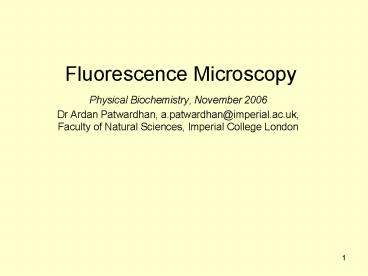Fluorescence Microscopy - PowerPoint PPT Presentation
1 / 21
Title: Fluorescence Microscopy
1
Fluorescence Microscopy
- Physical Biochemistry, November 2006
- Dr Ardan Patwardhan, a.patwardhan_at_imperial.ac.uk,
Faculty of Natural Sciences, Imperial College
London
2
Fluorescence
- Quantum Efficiency Q.E. Emitted photons/
Absorbed photons - The Molar Extinction Coefficient, e (M-1cm-1) is
the absorbance of a 1 molar solution in a 1 cm
lightpath at a specified wavelength.
3
Confocal Microscopy
- Only one point in the specimen is imaged at any
one given time - By scanning the specimen in 3D, a 3D
reconstruction of the specimen can be obtained
4
Confocal Resolution
- Lateral resolution
- Axial resolution
- Ex l 400nm, n 1.5, NA 1.4 ? Dx 0.13
mm, Dz 0.43 mm
5
Case Study The glomerulus
- The glomerulus is the main filter of the nephron
and is located within the Bowman's capsule. The
glomerulus is semipermeable, allowing water and
soluble wastes to pass through and be excreted
out of the Bowman's capsule as urine - The glomerulus is quite big (100-200 mm), which
is why serial sectioning has to be used in
combination with confocal microscopy to image the
whole structure
Microsc. Microanal. 12, 262268, 2006
6
Problems Speed
- Scanning a 3D specimen point by point takes some
time - Hybrid techniques have therefore been developed
that compromize on confocality in order to gain
speed - On such technique involves scanning one line in
the specimen at a time onto a CCD detector - The loss of resolution in the z direction is not
that pronounced - Another technique involves scanning multiple
points (well separated in space) in parrallel
7
Problems Cross-talk
l
Detector 1
Detector 2
8
Problems Fading
- Not well understood - Free radicals are thought
to be an important culprit ! - Many anti-fading agent now available
- Anti-fading agents can be very cyto-toxic !
9
Two photon microscopy
- Possible to use two photons of half the energy
normally required if intensity is high enough - Intensity high enough only in focal region 3D
localization with the need for confocal!
10
Advantages/Disadvantages
- Use of IR excitation allows penetration into
deeper tissue - Bleaching and phototoxic effects limited to focal
region
- Resolution is slightly worse than confocal
- Requires lasers capable of generating intense
short (100fs) pulses
11
Deconvolution microscopy
- In a deconvolution microscope, several images of
the specimen are taken while moving the specimen
towards the objective - No scanning in the x-y plane or pinholes is
involved - The smudging of information in the z-direction is
mathematically compensated for computationally - Simple, cheap and quick
- For many complicated specimens, not as good as
confocal or two-photon
12
FRET/ FRAP/anisotropy/liftetime imaging
- Most of the spectroscopic techiques that we have
studied can be combined with microscopy in order
to perform 3D/4D studies
13
Antibody labeling
- Amplification of fluorescence signal with
indirect immuno-labeling - May however lead to greater background signal
14
Example Direct antibody labelling
- Bovine pulmonary artery endothelial cells labeled
with direct antibody probes for tubulin (green)
and the mitochondria (red). Nonspecific stain for
nuclei (blue)
15
Example Indirect antibody labelling
- Formation of the cephalic furrow in the anterior
end of a developing Drosophila melanogaster
embryo. A primary antibody to neurotactin was
visualized using a red-fluorescent Cy3 dye
secondary antibody. Primary antibodies to plasma
membranebound myosin and to nuclear-localized
even-skipped (Eve) protein were visualized with
green-fluorescent Alexa Fluor 488 goat antimouse
IgG antibody and Alexa Fluor 488 goat antirabbit
IgG antibody, respectively. The nuclei were
stained with blue-fluorescent Hoechst 33342.
16
FISH Fluorescence in-situ hybridization
- Useful for chromosomal studies
- Especially when combined with multiple labelling
17
Example FISH
- Human metaphase chromosomes normal (left) and
cancerous (right) - Multicolored chromosomes on the right reveal
chromosomal translocations and other aberrations
in the cancerous cell line
18
GFP Green Fluorescent Protein
- In vivo reporter from Aequorea victoria (jelly
fish) - The FP gene is fused to the gene of interest and
as the fusion protein is expressed, one can
localize or track the movement of the tagged
protein in living cells - GFP has a relatively high Q.E. and is quite
robust, possibly due to the barrel-like
structures protecting and isolating the buried
chromophore from the environment - An number of other fluorescent proteins are now
available spanning the visible spectrum
19
Concentration measurements
- Calcium gradients in neurons
- High temporal and spatial resolution incompatible
with precise measurements
Indo-1
20
Studies on living cells
- Inverted microscope for easy access to specimen
- Constant temperature stages and perfusion
apparatus - Non-cytotoxic wavelengths and anti-fading agents
21
Main Points
- Confocal/two-photon and deconvolution
microscopies make it possible to image specimens
in 3D - Most of the fluorescent techniques used in
spectroscopy can be combined with microscopy to
study phenomena in 4D - Fluorescent proteins are a major tool in
visualizing intracellular distributions and
dynamics































